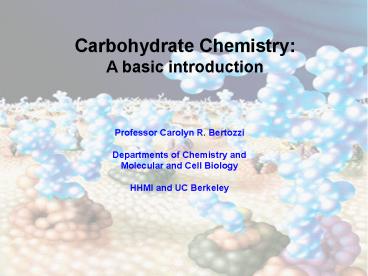Carbohydrate Chemistry: - PowerPoint PPT Presentation
1 / 38
Title:
Carbohydrate Chemistry:
Description:
Two common forms of protein glycosylation in mammals. Conserved pentasaccharide core ... Lovenox Cardiovascular disease Aventis. Miglitol Diabetes Bayer AG ... – PowerPoint PPT presentation
Number of Views:1612
Avg rating:3.0/5.0
Title: Carbohydrate Chemistry:
1
Carbohydrate Chemistry A basic introduction
Professor Carolyn R. Bertozzi Departments of
Chemistry and Molecular and Cell Biology HHMI
and UC Berkeley
2
- Lecture outline
- Overview of glycoconjugate structures
- Features of monosaccharides
- Synthesis of the glycosidic bond
3
Oligosaccharides are major components of the cell
surface
Oligosaccharides
Glycoprotein
Glycolipid
4
Polysaccharides are biosynthesized inside cells
on protein or lipid scaffolds
5
(No Transcript)
6
(No Transcript)
7
Two common forms of protein glycosylation in
mammals
Conserved pentasaccharide core
Conserved monosaccharide core
8
Examples of glycolipids
Glycolipid found in the brain
Glycosylphosphatidyl inositol (GPI) anchor found
on membrane proteinsinvolved in immune
Modulation (Campath) and on Parasite membrane
proteins (malaria, trypanosomes)
9
Examples of carbohydrate-based drugs
10
Examples of glycosylated natural products
11
Chemical synthesis of carbohydrates is important
for Studying their biological activities
Development of new therapeutic compounds
Examples of approved carbohydrate
drugs Substance Indication Company Acarbose D
iabetes Bayer AG AMVISC Opthalamic
surgery Anika Therapeutics Hyalgan Osteoarthriti
s FIDIA/Sanofi Lovenox Cardiovascular
disease Aventis Miglitol Diabetes Bayer
AG ORTHOVISC Osteoarthritis Anika
Therapeutics Relenza Influenza Glaxo
Smithkline Tamiflu Influenza Roche SOLARASE Ac
tinic keratosis Hyal Pharmaceuticals Topamax Epi
lepsy J J Voglibose Diabetes Takedo/Abbott
12
- Lecture outline
- Overview of glycoconjugate structures
- Features of monosaccharides
- Synthesis of the glycosidic bond
13
Free monosaccharides are hemiacetals that can
undergo a reversible anomerization reaction
14
Monosaccharides are linked together by glycosidic
bondsdefined by regiochemistry and
stereochemistry
Features of oligosaccharides They can be
branched, unlike peptides and nucleic acids
Combined with the requirement of regiochemistry
and stereochemistry, this makes them hard to
synthesize
15
- Synthesis of glycosidic bonds requires
- 1. Control of regiochemistry
- Use of selective hydroxyl group protection
- 2. Control of stereochemistry
- Stereoelectronic effects (the anomeric effect)
- Neighboring group participation
16
The anomeric effect A stereoelectronic
effect that governs the preferred orientation of
acetals
17
(No Transcript)
18
- Lecture outline
- Overview of glycoconjugate structures
- Features of monosaccharides
- Synthesis of the glycosidic bond
19
Generalized glycosidic bond coupling reaction
20
(No Transcript)
21
(No Transcript)
22
(No Transcript)
23
(No Transcript)
24
(No Transcript)
25
(No Transcript)
26
(No Transcript)
27
(No Transcript)
28
(No Transcript)
29
(No Transcript)
30
(No Transcript)
31
(No Transcript)
32
(No Transcript)
33
Enzymatic synthesis of glycosyl bonds obviates
the two major problems encountered in chemical
synthesis
Requirement for numerous protecting groups for
regiochemical control Control of anomeric
stereoselectivity
Enzymes orient the glycosyl donor and acceptor to
catalyze the formation of a specific linkage
34
(No Transcript)
35
Nucleotide sugars used in mammals
36
(No Transcript)
37
Present limitations of enzymatic oligosaccharide
synthesis 1. The nucleotide sugars are
expensive 2. Not all enzymes are available in
recombinant form 3. The enzymes do not accept
many unnatural sugars, thus modified
oligosaccharides cannot be readily made 4. Most
glycosyltransferases are inhibited by high
concentrations of the nucleotide product
thus, large scale synthesis is difficult
Many groups are seeking solutions to these
problems so stay tuned!.
38
The present challenge Integrating
oligosaccharide synthesis with protein chemistry
to make glycoproteins































